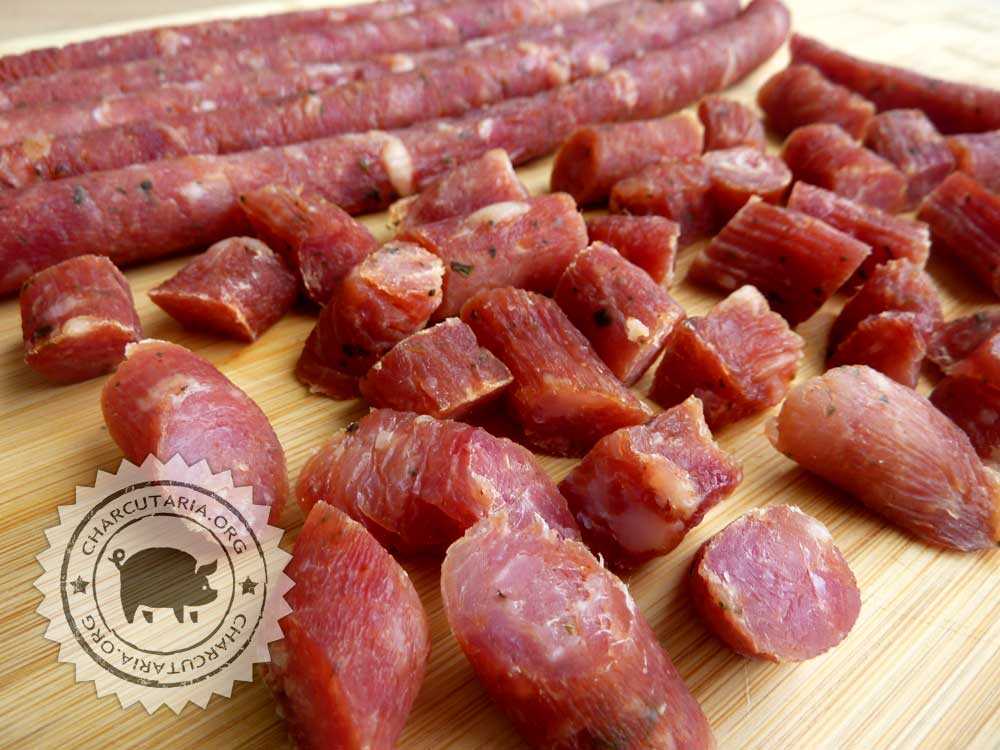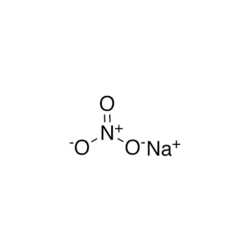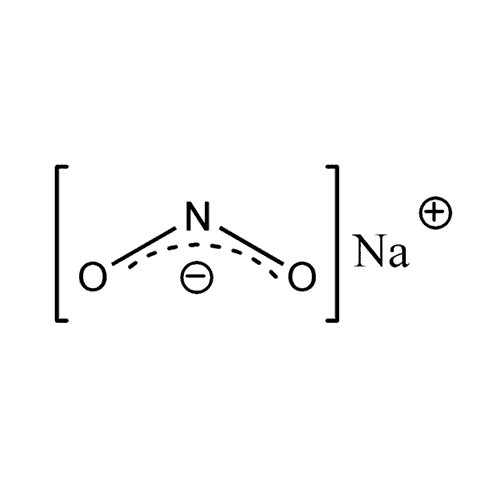
Celery, for example, contains nitrates, which under the right conditions can transform into nitrites and help color, prevent rancidity and inhibit anaerobic pathogens such as Clostridium botulinum. Beetroot can also be used for similar purposes, while cherry powder contains antioxidants and a high concentration of ascorbic acid (vitamin C) which increases the rate of nitric oxide reduced by nitrite, resulting in a reaction with myoglobin and the transformation into nitrosyl -hemochrome when heated, setting the reddish color typical of cured meats. Vinegar (acetic acid) and lemon juice can also be used, as acetic and citric acids are effective in preventing the growth of bacteria, including Listeria monocytogenes.
Vegetable powders are not normally used in sausages, but their high nitrate content makes them an important natural source of these compounds, with examples such as celery, kale, chard, beets and carrots. These ingredients are used separately or in combination to mask the flavors of these vegetables, which are not associated with those traditionally found in sausages.
O Celery powder contains 3% nitrates, the same as powdered chard. Therefore, with the application of these compounds, separately or combined, with a concentration of 0.4% in the formula of a ham, for example, 120 mg/kg of nitrate is obtained. It must be considered that in the process of reducing nitrate to nitrite there is a loss of at least 10%, which is not converted into nitrite; and in the nitrification and cooking process, 10% to 20% more final nitrite can be lost. Even with these nitrite losses, the final concentration of more than 80 mg/kg of nitrite would be sufficient to obtain the expected functionality of nitrites in the sausage.
An important thing to consider is that nitrate of plant origin must be converted into nitrite as only nitrite has the desired functions. To convert nitrate into nitrite, nitrate-reducing enzymes or starter cultures are required. Micrococci and staphylococci have an enzyme system called nitrate reductase, and these bacteria are used for this purpose. Bacteria such as Lactobacillus curvatus, Lactobacillus sakei, Staphylococcus carnosus and/or Staphylococcus xylosus are used. Micrococcus, Staphylococcus xylosus and Staphylococcus carnosus, which reduce nitrate to nitrite at temperatures between 15°C and 20°C, but are much more efficient at temperatures higher than 30°C.
The use of ascorbic acid with a concentration of 0.3% favors the reduction of nitrates into nitrites, therefore, its use is recommended. Furthermore, ascorbic acid has a high antioxidant power and maintains the color of ham and other sausages unchanged.
Studies on the use of vegetables in natural healing
Celery powder
Celery was the first vegetable used as a source of nitrate for alternative curing of meat. From the beginning it was added in powder form, but advances in science have led to the improvement of this product. One study investigated the effect of micronized celery powder (particles smaller than 10 microns) on curing pork sausages. The different sizes of ingredient particles (265 μm, 68 μm and 7 μm) showed different results. The researchers reported that celery powder with larger particles was more efficient in curing, while powder with smaller particles tended to improve the oxidation of the sausages. None of the texture parameters in the sausages were affected by the particle size of the celery powders;
Spinach Extract
One study analyzed the effect of fermented spinach extracts as a source of pre-converted nitrite on the development of curing color in slices (2 cm thick) of pork loins. The most significant results were the development of the curing color and the degree of fat oxidation in the meat slices. The luminosity and yellow intensity values of the samples with spinach extract were higher than those of the control samples (with and without nitrate). However, red intensity values increased in cooked cured meat samples as the extract level increased, whereas yellow intensity reduced in the presence of increasing extract level. Oxidation (evaluated as thiobarbituric acid reactive substance values or TBARS) of samples with spinach extract decreased with increasing percentage of added extract. Thus, meat cured with 30% fermented spinach extract resulted in the lowest TBARS values of all treatments (0.18±0.02 mg MA/kg) and only slightly higher than the control treatment cured with nitrite (0.12±0.05 mg MA/kg). Furthermore, the viable bacteria counts of the samples cured with the extracts ranged from 0.34 to 1.01 Log CFU/g. Neither E. coli nor coliform bacteria were observed in any of the samples cured with extracts or with nitrite (control). The researchers concluded that fermented spinach extract can be added to meat products to improve curing characteristics;
Radish powder
Radish has a high content of nitrates (between 1,878 and 6,260 ppm), as well as bioactive compounds such as ascorbic acid, polyphenols and flavonoids. In one study, the effects that different concentrations of radish powder would have and the incubation times on the physicochemical properties and pigments of alternatively cured meat were investigated. The experiment was divided into seven groups, with different concentrations of radish powder and different incubation times: control (0.01% of sodium nitrite), treatment 1 (0.15% of radish powder and 2 hours of incubation), treatment 2 ( 0.15% of radish powder and 4 hours of incubation), treatment 3 (0.30% of radish powder and 2 hours of incubation), treatment 4 (0.30% of radish powder and 4 hours of incubation), treatment 5 (0.30% of celery powder and 2 hours of incubation) and treatment 6 (0.30% of celery powder and 4 hours of incubation). Among the scientific discoveries, it is highlighted the fact that, although the intensity of red was not significantly different between any of the alternative cure treatments and the nitrite control, those samples with 0.30% of radish or celery powder demonstrated a increase in nitrite content, nitrosylhemochrome content and curing efficiency when the incubation time was increased from 2 to 4 hours. Among the meat products cured with radish powder, treatment 4 demonstrated the greatest increase in residual nitrite content, nitrosylhemochrome content and curing efficiency, but demonstrated the lowest lipid oxidation. The results suggest that increased horseradish powder concentrations and longer incubation times would be more suitable for manufacturing alternatively cured meat products comparable to traditionally cured products treated with synthetic nitrite;
Swiss chard solution
The average nitrate content in chard can range from 560 to 3,400 ppm, according to research from different sources. Therefore, a study aimed to analyze the possibility of using pre-converted chard as a source of natural nitrite for cured meat without the direct addition of sodium nitrite. In the research, freeze-dried chard powder was used, which was obtained from a supplier in the local market, diluted with distilled water, and the chard solution at 10% (w/v) was incubated with a commercial initial culture of Staphylococcus carnosus only. , at 37°C, for 24 hours. Immediately after incubation, the chard solution, now fermented, was used to form different brines and create different treatments to cure pork loins. Among the most relevant scientific discoveries, the researchers reported that the oxidation of pork loins, measured in levels of thiobarbituric acid, reduced as the level of chard fermentation in the formulations increased; no significant differences were found between treatments in relation to sensory characteristics of flavor, chewiness or juiciness, nor in relation to the general acceptance of pork loins. However, the color of the analyzed samples increased significantly with the increase in the concentration of chard fermentation added to the loins. The researchers concluded that chard used in this format (yeast) is a viable alternative to replace sodium nitrite as an alternative curing agent.
References
KIM, T.-K.; KIM, Y.-B.; JEON, K.-H.; PARK, J.-D.; SUNG, J.-M.; CHOI, H.-W.; HWANG, K.-E. & CHOI, Y.-S. Effect of fermented spinach as sources of pre-converted nitrite on color development of cured pork loin. Food Science of Animal Resources. vol. 37, no. 1, p. 105-113, 2017.
KIM, T.-K., HWANG, K.-E.; SONG, D.-H. et al. Effects of natural nitrite source from Swiss chard on quality characteristics of cured pork loin. Asian-Australasian Journal of Animal Sciences (AJAS). vol. 32, no. 12, p. 1933-1941, 2019.
RAMACHANDRAIAH, K. & CHIN, KB Antioxidant, antimicrobial, and curing potentials of micronized celery powders added to pork sausages. Food Science of Animal Resources. vol. 41 1, p. 110-121, 2021.
BAE, SM; CHOI, JH & JEONG, JY Effects of radish powder concentration and incubation time on the physicochemical characteristics of alternatively cured pork products. Journal of Animal Science and Technology. vol. 62, no. 6, p. 922-932, 2020.





